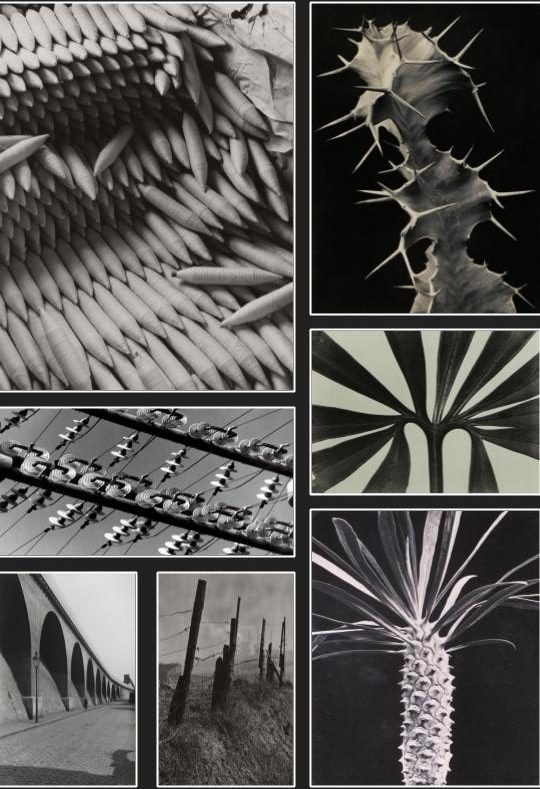Introduction to Albert Renger-Patzsch:
Albert Renger-Patzsch was a German photographer who took a liking to the New Objectivity ways of photographing, and helped to develop the movement with his own work. New objectivity focused a lot on taking photographs in a bold, documentary like manner, showing the subjects in a simple yet striking form. Renger took a forward approach to photography, using his camera almost like an eye, simply photographing what was seen in the way that an individual would see it. Albert’s photography matched the movement of New Objectivity well, and through the use of black and white tone contrast, his work drew attention to the new way of photographing subjects the way that they were seen in everyday life. Albert focused on subjects that could be found in everyday life, making his photographs more relatable to the viewer. He often focused on nature, taking close up photographs of plants and flowers, showing the details of nature in a simple yet eye catching manner. A lot of his photographs take advantage of natural shadows and patterns, exaggerating them by editing the colour to grey-scale.
Introduction to New Objectivity:
Renger-Patzsch focused a lot of his work around the “New Objectivity” expression of photography, which gained popularity during the 1920’s as a reaction against expressionism. New Objectivity focused on depicting subjects of photographs in a more scientific, documentary style manner. Photographs taken during the surge of New Objectivity often maintained sharp focus on an obvious and well framed subject, and depicted the subject how it was seen with the human eye, rather than distorting or abstracting it. As a whole, New Objectivity presented photographs as precise, literal, and scientific in appearance, which greatly contrasted it’s predecessor, Expressionism.

Exploration of the formal elements:
Albert Renger-Patzsch experimented a lot with lighting, shadows, form, lines and texture. His photographs often take advantage of the contrasting tones in gray scale; using the contrasting colours to emphasize the details of the images. Renger also experimented a lot with texture, using close ups to emphasize the texture of the subjects he used, while positioning his lighting to highlight the contrasting textures that can be found on a single image. The final images that Albert produced were sharp and bold, and the dark and light colours that he edited into the images helped to emphasize this bold photography. The position and settings of Albert’s camera were also important in creating his photographs. Albert made use of the zoom feature of his camera, taking close ups of plant life and everyday objects to show their details. A lot of Albert’s subjects include more harsh objects, such as thorn covered plants or telephone wires, and the way he positioned his camera helped to frame the image in a bold way, drawing the viewer’s attention directly to the center of the photograph. This technique helped to add to the harshness of the photographs he took, along with the use of harsh subject matters. The combination of gray scale, closeups and bold subjects helped Albert create an overall eye catching and striking style that matched the wave of New Objectivity.

Further Analysis:
Renger-Patzsch looks for the details in his subject, zooming into the more complex areas and drawing attention to the complexities of everyday objects. Albert focuses a lot on industrial hardware, including cranes, machines and factory spaces, and draws attention to the detail found there. This often helps to add to the objectivity of Renger-Patzsch’s work, as it allows for the viewer to see these machines as they would usually see them with their own eyes, but allows them to concentrate more on the details that they would normally miss. Examples of where Renger-Patzsch has payed extra attention to the detail present in the frame of his photographs can be seen below.



My Response:
After analyzing his work, I have taken inspiration from Albert Renger-Patzsch, and will be using his style of photography to create a photo shoot of my own, keeping in mind his use of camera settings, subjects, and his frame of mind in reference to New Objectivity. Below are the contact sheets I have produced after taking photographs inspires by Renger-Patzsch:
Response Analysis:
As can be seen in the above photo-shoot, I have focused on aligning my photography with the New Objectivity movement that influenced Renger-Patzsch with his own work. I have focused on using subjects including both nature and machinery, where I have been able to mimic the style of Renger-Patzsch. I feel that, by taking very front facing photographs of subjects, that are not altered or abstracted, I have been able to capture the style of the New Objectivity movement in my images.
———-individual (x3)———
In order to allow my photo- shoot the appear to have taken inspiration from Renger-Patzsch, I decided that editing the images would be the best way to emphasis the shape and contrast of the images. Renger-Patzsch often used grey-scale when editing his images, in order to draw attention to the subject of the image, rather than the color, and to present the subjects in an even more scientific, almost clinical way. In order to mimic this effect, I have selected the images that I feel are the most relevant, and have edited them to mimic the colour pallet of Renger-Patzsch’s work. The products can be seen below:

Don’t forget to update with your missing images Emily (btw everything else is absolutely top class! So really well done!)